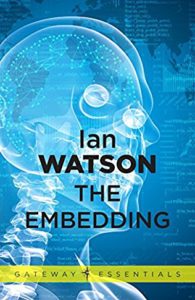 You have to be interested in language for this classic sci-fi to hold you. Linguistics, psycholinguistics, the origins of language — those are the main themes. The story is almost incomprehensible, the characters distant, and the pace slow. Other than that, though…
You have to be interested in language for this classic sci-fi to hold you. Linguistics, psycholinguistics, the origins of language — those are the main themes. The story is almost incomprehensible, the characters distant, and the pace slow. Other than that, though…
Three story themes are roughly twisted together. Any one of them could be the basis for a good novel. The opening theme was a lab where scientists “raised” a group of children in artificial language environments to see what parts of language are inborn and which parts are learned. What if humans grew up in a place where the only language was artificially constructed by a computer on the basis of nested recursion (the eponymous ‘embedding’)?
Invoking Chomsky’s theory of inbuilt, universal grammar, it should be possible for children to pick up any arbitrary language as long as it followed the rules, even a language that no human ever spoke. It’s a question of genuine interest but the theme degenerates into chaos and no answer is provided, nor even much exposition. At the critical point, the children’s brains ‘overload’ and they throw tantrums, or something like that. So I guess the answer is ‘no’?
Another theme concerns a pre-industrial society of indigenous people in the upper Amazon who have developed a quasi-telepathic language that lets them access alternate realities, with the help of a hallucinogenic fungus which sounds a lot like Ayahuasca. The Americans have built a huge hydroelectric dam which threatens to destroy the tribe while an idealistic French anthropologist tries to warn them, at least until he takes the drug himself, “goes native” and loses his mind.
Again, it’s a worthy theme, one explored very effectively by Mario Vargas Llosa in his novel, The Storyteller (1987) which includes, remarkably, many of the identical elements. In Watson’s novel, despite some indelible scenes, the ideas collapse under their own weight.
A third theme is also strong in principle. Aliens appear and want to trade technology of interstellar travel for human brains. What could go wrong? They want the brains because, as far as I could tell, they collect the realities associated with languages, and they know that language is not merely algorithmic, but incorporates a lifetime’s social and environmental experience, all of which would be contained in the brains, right?
Fair trade, say the always-evil military and their scientists. A mission is sent to gather a batch of brains from among the native peoples in the Amazon, though all does not go as planned, for reasons unclear.
The last section of the book is so chaotic, it’s hard to tell what happened. I think it was an attempt to create a hallucinogenic “contact high” in the reader with a drug-trippy scene where logic and language separate. Maybe it was supposed to be something like the ending “light show” in 2001: A Space Odyssey, which came out in 1968. The strategy worked remarkably well in Llosa’s novel, The Storyteller, which made me woozy, and in P.K. Dick’s Ubik. But Watson’s was just dense wordsmithing. Hard to say why it wasn’t effective.
As psi-fi, The Embedding gets points for effort. The mysteries of language are among the most fundamental questions of human psychology in a technology world. And despite its flaws, it’s worth reading as one of the first sci-fi novels to get past starships and ray-guns and bring the “softer” human sciences in for study.
Watson, Ian (1975). The Embedding. New York: Bantam (217 pp.)